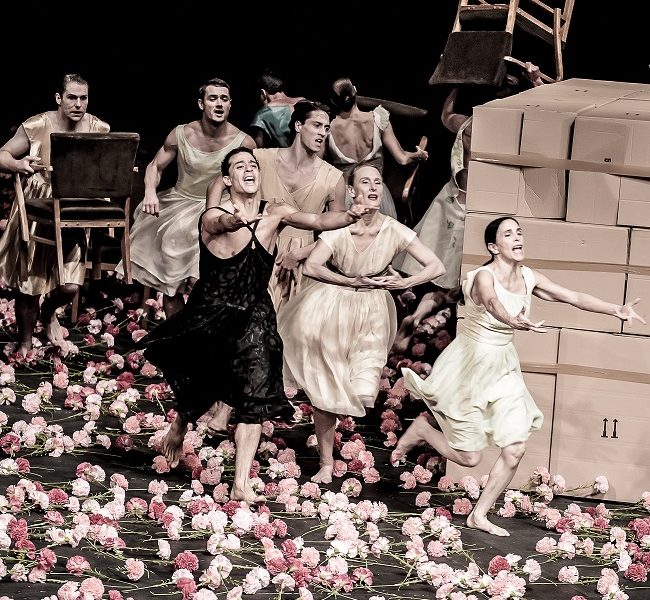DOUBLETAKE of Carnations by Ronit Ziv- צפייה חוזרת בציפורנים מאת רונית זיו

*english follows
בצפייה חוזרת בציפורנים האגדי של פינה באוש (הראשונה הייתה בקיסריה לפני מספיק שנים ,1991?) אני מתבוננת כמו בגלויה ששולחים קרובי מארץ רחוקה. יפה שם, וקריר אבל.. אז הקריטי חסר, זה שתמיד אפיין את כל יצירותיה של פינה באוש. הקריטי בשבילי הוא הרגע שההתרחשות הבימתית גולשת אל הקהל, מאיימת, מדירה שינה מעיני לאחר המופע וגורמת להזדהות עם הדמויות/ הרקדנים לחשוש לגורלן הפיסי ומעוררת את הדאגה לשלומן הרגשי. כך אני זוכרת, את הדואט המרגש בין יאן מינרקין (Jan Minarkin) לביאטריס ליבונטי (Beatrice Libonati) בכחול הזקן (1977). הוא גדול מידות, היא קטנה. הוא מניף אותה, מתעלל בה, והיא כחומר ביד היוצר. קשה היה לראות. כמו שקשה היה לראות את קבוצת הגברים על הבמה מטיחה נשים כנגד הקיר. את הקהל זה הצמיד חזק לכיסא. זוכרת את התאור המילולי והחזק של פרופסור נורית יערי, כשהיא ניסתה להסביר לי מה עבר עליה ועל קהל שם, שראה לראשונה את יצירות המוקדמות של פינה באוש. היא לא ציינה דיוק, ולא ציינה פרפקציוניזם טכני ביצועי, חלילה. היא רק אמרה שהם לא האמינו שזה קורה על הבמה על אמת. ישבו בקהל ובכו.
גם כולנו זוכרים בע”פ את החיבוק המפורסם של קפה מילר (1978) בין דומיניק מרסי (Dominique Mercy) ומאלו איירד (Malou Airaudo). דומיניק מחזיק את מאלו ומפיל אותה ויאן מינרקין מסדר את החיבוק בין הרקדנים מחדש ובסבלנות רבה. מניח יד ועוד יד, בודק שהחיבוק חזק ופונה ללכת מהם, אך כמו מתוך כניעה לכח הכבידה, או בפרשנות שלי מכוחו של הרגל, בכל פעם החיבוק נפרם, כמו קשר שנפרם כל פעם מחדש, הרקדנים נכשלים בחיבוק. נוצר הרושם המיידי כי זה סיפורם האישי, של דומיניק ומאלו. זוהי מסצינה שנוצרה מתוכם, בהשראתם וזו היד המכוונת והקסומה של פינה באוש. אנחנו לא מצליחים להפריד בין הרקדן ובין התפקיד. הם דבוקים זה בזה.
עד היום אני צופה שוב ושוב בפולחן האביב (1975) במיוחד בסולו המסכם של הרקדנית שלגופה כותנת אדומה. הכתפייה שמוטה מה שגורם לחשיפת חלק מהחזה של הרקדנית. ב6 הדקות האחרונות ביצירה, אנחנו עדים לריקוד שמאופיין בתנועות של נפילה ועלייה מהאדמה, כל פעם נראה כי הרקדנית תיפול לאדמה ולא תקום אך היא ממשיכה לנוע, בתנועה ספירלית, ותנועתה נעשית משוחררת יותר ויותר עד שהיא נכנעת ונופלת לאדמה.
הרקדנים האגדיים של פינה מעולם לא התאמצו לשכנע שהם על הסף, הם היו שם, ללא מאמץ ושאבו את הצופה יחד איתם אל השאול, אל האהבה האינסופית, אל המאבק הנצחי בין גברים ונשים, אל הדיכוי של מי שפליט וחלש, מותירים אותנו בעולם קסום-כאוטי בו התלבושות, התפאורה והמוסיקה מנחמים קמעה, ומערסלים אותנו עד לגל הבא של הכאב.
מה שמגלה שוב ושוב כי זה לא למידת הכוריאוגרפיה ותפאורה מהממת אלא הנשמה המגע של היוצרת הגדולה שלי באופן אישי יתכן סובייקטיבי ויתכן שלא… בביצוע ציפורנים של להקת מחול וופרטל בתל-אביב 2019 היה חסר. ואוו כמה חסר.
In a repeat viewing of the legendary Carnations by Pina Bausch (my first was in Caesarea many years ago, 1991?), I observe as one views a postcard sent from relatives in a distant country. It’s beautiful there but chilly. The essential element is missing, the thing that always characterized Pina Bausch’s works. The essential, for me, is the moment in which the action on stage floods out into the audience, threatens, keeps me up at night and makes me identify with the characters/dancers and to worry about their physical emotional well-being.
That’s how I remember the moving duet between Jan Minarkin and Beatrice Libonati in Bluebeard (1977). He is large, she is small. He flings her around, tortures her, she is clay in the hands of the sculptor. It was difficult to see. It was similarly difficult to watch a group of men slamming women against the wall. It glued the audience to their seats. I remember the strong, verbal description of Nurit Yaari’s, when she tried to impart what she and the audience experienced upon first viewing Pina Bausch’s early works. She didn’t mention precision nor perfectionism or technical execution. She just said that they couldn’t believe that it was really happening on stage. They sat in the audience and cried.
And we all remember by heart the famous hug of Café Muller (1978) between Dominique Mercy and Malou Airaudo. Dominique holds Malou and drops her and Jan Minarkin rearranges the hug over and again with great patience. He places one hand and then another, checks that the embrace is strong and turns to leave them but each time the dancers fail at this hug. The impression is instantly made that this is their personal story, Dominique and Malou’s. It is from a scene they created and inspired by them and it is Pina Bausch’s magical and guiding hand that led it. We cannot separate between the dancer and the role. They are joined.
Even today I watch The Rite of Spring (1975) over and over, especially the culminating solo of the dancer in the red nightgown. Her strap has fallen exposing part of her breast. For the last six minutes of the work, we are witnesses to movement that is composed of falling and recovering from the Earth. Each time it seems the dancer will fall and stay down but she continues to move, in spirals, and her movement becomes more and more free until she finally gives in and collapses to the ground.
Pina’s legendary dancers never tried to convince us that they were on the edge, they were they without effort and they pulled the viewer into the chasm with them, into the endless love, the forever struggle between men and women, to the oppression of the weak and dejected… They left us in a chaotic-enchanted world in which the costumes, set and music comfort us some, soothe us until the next wave of pain arrives.
What is exposed time and again is that it is not the choreography or the beautiful scenery rather the soul and handprint of the world’s greatest choreographer (in my eyes), Soviet or not, that makes the magic….and in the performance of Carnations by Tanztheater Wuppertal in 2019 in Tel Aviv that was missing. And wow, how much it was missed.
 Ronit Ziv, one of Israel’s most active choreographers, has performed and has been creating work for dance and theater companies in Israel, Europe and the former FSU since 1999. An experienced teacher, she taught the Batsheva Ensemble for three years and currently teaches at Jerusalem Academy for Music and Dance.
Ronit Ziv, one of Israel’s most active choreographers, has performed and has been creating work for dance and theater companies in Israel, Europe and the former FSU since 1999. An experienced teacher, she taught the Batsheva Ensemble for three years and currently teaches at Jerusalem Academy for Music and Dance.
Evolving in the field of dance since the 1990’s, Ronit devotes herself to the exploration of movement and its sources, seeking authenticity of the gesture. Her significantly radical approach is based on the relations of text and choreography, imagining the everyday practice, with the analyses of gesture in the context of a living environment
Ronit has since appeared at the Pina Bausch Festival and has been working as an independent choreographer and created for numerous companies, including, Batsheva Ensemble CNDC l`esquisse, Galili Dance Company and Campania Instavel.
